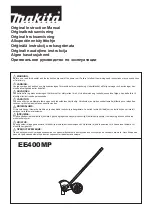
26
Useful information
Distillation is a thermal separating process for liquid compounds
based on substance-specific, pressure-dependent boiling points
through evaporation and subsequent condensation.
The boiling point temperature decreases with decreasing external
pressure which means that work is usually done under reduced pres-
sure. In this way the heating bath can be maintained at a constant
temperature (e.g. 60 °C). Using the vacuum, the boiling point is set
with a steam temperature of approx. 40 °C. The cooling water for
the condensation condenser should not be warmer than 20 °C (60-
40-20 rule).
A chemical resistant membrane pump with a vacuum controller
should be used to create the vacuum. The pump is protected from
solvent residue by the addition of a Woulff bottle and/or a vacuum
separator.
Working with a jet pump to create a vacuum can only be recom-
mended to a limited extent as the solvents may contaminate the en-
vironment when using these systems.
Speed, temperature, flask size and system pressure all affect the
evaporator air capacity.
The optimum capacity of the flow-through condenser is approx.
60%.
This corresponds to condensation on approx. 2/3 of the cooling
coil. With larger capacities there is the risk that the uncondensed
solvent vapor will be extracted.
The device is equipped with a Lift safety
unit.
If the power cuts out, the evaporation
flask is automatically lifted out of the
heating bath by an integrated gas spring.
“
CAUTION!
The safety lift must be
checked daily before use. See safety
notes / safety lift ! “
The glass apparatus can be evacuated
after power outage!
When using other types of condensers such as dry ice or intensive
condensers as well as when using return distillation distributors
with slip-on condensers, it may be necessary to reduce the mass
of the media to compensate for the mass of this additional glass-
ware. Thus, prior to distillation, check whether the lift goes up
without power when laden with the glass and distillation material.
The device is designed for operation with a cooling water supply
system (e.g. laboratory thermostat), but can also be run off a wa-
ter supply line. Please refer to the Technical Data for information
on cooling water pressure, temperature constancy, and flow rate.
Setting up
Drive RV 8
1.) Mount the base to the lift. (Fig. 7)
• Apply Cylindrical M6x25
(
F
) (4x) and Serrated washer M6
(
G
) (4x)
to mount base
(
H
) with Lift Unit
(
I
)
after you unpack the package.
(Fig. 7)
G
H
I
F
Fig. 7
2.) Remove transportation lock (Fig. 8)
• Hold the lift with your
hand on the height
position and remove the
thumb screw (
J
) by turning
counterclockwise on the
back of the appliance.
Take care! DANGER!
Once the transportation
lock has been removed, the
lift moves fast to its upper
end position. The distance is
approx.120 mm.
J
Fig. 8
4
CAUTION
CAUTION
Содержание RV 8
Страница 1: ...20000006119 RV 8_072017 IKA RV 8 ...




































